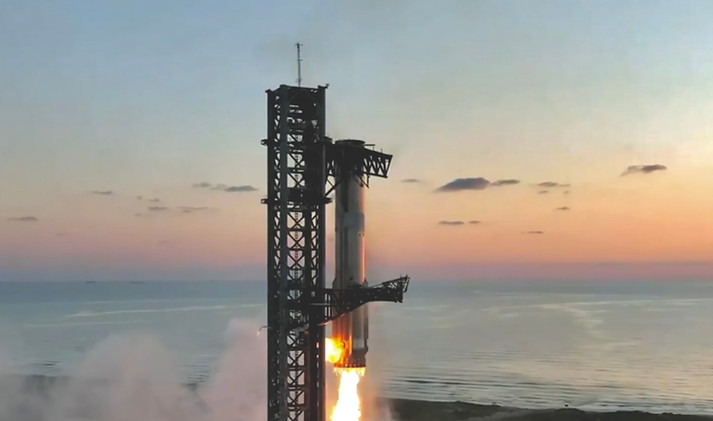Trang web được tài trợ bởi các khoản đóng góp tư nhân

Tin tức vũ trụ
Chào mừng đến với Trung tâm nghiên cứu Boos Tin tức không gian
Cuộn xuống trang để xem tin tức đương đại mới nhất
Tin tức về không gian của Hoa Kỳ và khi bạn cuộn xuống, hãy xem các liên kết về hàng không vũ trụ của chúng tôi.
TIN TỨC
Ngày 13 tháng 10 năm 2024

Tên lửa đẩy Super Heavy quay trở lại địa điểm phóng để được tháp phóng đón trong chuyến bay ngày 13 tháng 10. Tín dụng: SpaceX
MILAN — SpaceX launched its fifth Starship vehicle Oct. 13, successfully making an unprecedented “catch” of its Super Heavy booster back at the launch site.
The Starship/Super Heavy vehicle lifted off from the company’s Starbase site at Boca Chica, Texas, at 8:25 a.m. Eastern on a mission called Flight 5 by SpaceX.
The main upgrade for this test was an attempt by SpaceX to recover the Super Heavy booster by having it come back to the launch site, where it would be cradled by two mechanical arms, sometimes called “chopsticks,” attached to the launch tower it lifted off from. That required the booster to perform precise boostback and landing burns to guide the stage back to the launch pad.
The Super Heavy booster, known as Booster 12, achieved that feat. The booster descended over the pad and the two arms closed around the top of the booster, just below the grid fins, about seven minutes after liftoff, achieving the desired catch of the booster.
Achieving the launch pad return and landing is critical to SpaceX’s long-term ambitions for rapid reflight of the vehicle. In the company’s vision, the landed booster could be rapidly turned around on the pad, with a Starship attached for its next flight within days or even hours.
The success of the catch appeared to take even company leaders by surprise. “I don’t know what to say!” posted Gwynne Shotwell, president and chief operating officer of the company, on social media, attaching a video of the landing.
Before the launch, though, Bill Gerstenmaier, vice president of build and flight reliability, was optimistic about the catch attempt. “We landed with half a centimeter accuracy in the ocean” on the previous flight, he said at an Oct. 9 meeting of the National Academies’ Committee on Biological and Physical Sciences in Space, “so we think we have a reasonable chance to go back to the tower.”
The Starship vehicle, Ship 30, flew on a suborbital trajectory similar to the previous flight in June, reaching a peak altitude of 212 kilometers. The vehicle appeared to survive reentry in better condition than on that previous flight; SpaceX noted it made changes to Starship’s heatshield. The vehicle made a powered ocean “landing” in the Indian Ocean nearly 66 minutes after liftoff, with the vehicle, not intended to be recovered, exploding several seconds after splashing down.
“Ship landed precisely on target!” Elon Musk, chief executive of SpaceX, postedminutes after the landing. “Second of the two objectives achieved.”
Last-minute license
The launch took place less than 24 hours after the Federal Aviation Administration issued a revised launch license for the mission, the subject of controversy over the last month after SpaceX complained it had been informed by the FAA that the updated license would not be ready until late November.
The license required revisions to an environmental assessment because of changes in the flight profile, including a larger area where the interstage ring, also called a forward heat shield in FAA documents, might be dropped in the Gulf of Mexico as well as a sonic boom analysis for the returning Super Heavy booster.
That environmental analysis, signed and published a few hours before the license was granted, concluded “no structural damage or significant impacts to third-party structures is anticipated” from sonic booms. “No adverse impacts to biological resources in the Gulf of Mexico are anticipated as a result of the proposed change to the forward heat shield landing location,” it stated.
The analysis, though, does include several conditions related to the overall effects of Starship launches at Boca Chica, including “field experiments to determine the extent of the gravel plume impact area” caused by Starship launches, which would support any measures to protect bird nests in the surrounding wildlife preserve, as well as monitor other impacts of the launches on birds there. The company must also provide an annual certification “attesting to SpaceX’s compliance with all applicable environmental laws, regulations, permits, or other authorizations” relating to launches at Starbase.
SpaceX compliance to those laws has also been a topic of controversy regarding the permitting of a water deluge system at the pad, which resulted in the company agreeing to a nearly $150,000 fine from the Environmental Protection Agency for operating the deluge system with an EPA permit. The company noted it did have a permit from Texas regulators.
The revised license requires SpaceX to provide the company with the state and, when completed, EPA permits for the deluge system and “to send the FAA copies of all monitoring data within 45 days of sampling the use of its deluge system.”
The license does allow SpaceX to conduct at least one more launch, called Flight 6, using the same profile without obtaining another authorization from the FAA. “The SpaceX Starship/Super Heavy Flight 5 license authorization also includes FAA approval of the Flight 6 mission profile,” the agency stated. “The FAA determined the changes requested by SpaceX for Flight 6 are within the scope of what has been previously analyzed.” The agency didn’t state what those changes were.
Courtesy: Space News






